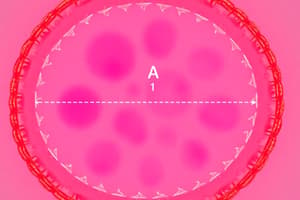Podcast
Questions and Answers
What is the main purpose of the G1 phase in the cell cycle?
What is the main purpose of the G1 phase in the cell cycle?
- Chromosome replication.
- Alignment of chromosomes.
- Protein and organelle synthesis. (correct)
- Cell division.
During which phase do sister chromatids separate from each other?
During which phase do sister chromatids separate from each other?
- Metaphase.
- Anaphase. (correct)
- Prophase.
- Telophase.
What occurs during the S phase of the cell cycle?
What occurs during the S phase of the cell cycle?
- Production of organelles.
- Replication of chromosomes. (correct)
- Cytoplasmic division.
- Chromosome condensation.
What is a characteristic feature of interphase in the cell cycle?
What is a characteristic feature of interphase in the cell cycle?
Which phase of mitosis directly follows prophase?
Which phase of mitosis directly follows prophase?
What is the shape created by chromatids during their movement towards opposite poles?
What is the shape created by chromatids during their movement towards opposite poles?
During telophase, what surrounds each set of chromatids?
During telophase, what surrounds each set of chromatids?
What cellular response occurs when cells in a petri dish come into contact with other cells?
What cellular response occurs when cells in a petri dish come into contact with other cells?
What role do cyclins play in the cell cycle?
What role do cyclins play in the cell cycle?
What happens to cells bordering an injury, like a cut on the finger?
What happens to cells bordering an injury, like a cut on the finger?
What is a characteristic of cancer cells in relation to cell growth control?
What is a characteristic of cancer cells in relation to cell growth control?
What are the two main groups of cell cycle regulators?
What are the two main groups of cell cycle regulators?
What happens during the formation of a cleavage furrow?
What happens during the formation of a cleavage furrow?
What is the primary reason cells cannot continue to grow indefinitely?
What is the primary reason cells cannot continue to grow indefinitely?
During which phase does the actual division of the cytoplasm occur in eukaryotic cells?
During which phase does the actual division of the cytoplasm occur in eukaryotic cells?
What happens to the volume of a cell in comparison to its surface area as the cell grows?
What happens to the volume of a cell in comparison to its surface area as the cell grows?
What are sister chromatids?
What are sister chromatids?
What is interphase characterized by in the cell cycle?
What is interphase characterized by in the cell cycle?
Which statement accurately describes the ratio of surface area to volume?
Which statement accurately describes the ratio of surface area to volume?
Which process must occur before a cell divides?
Which process must occur before a cell divides?
Which structure is used to connect sister chromatids?
Which structure is used to connect sister chromatids?
Flashcards
G1 Phase
G1 Phase
The first phase of the cell cycle. During this phase, the cell grows, increases in size, and synthesizes new proteins and organelles.
S Phase
S Phase
The phase of the cell cycle where DNA is replicated. This ensures that each daughter cell receives a complete copy of the genetic material.
G2 Phase
G2 Phase
The phase of the cell cycle where the cell prepares for division. During this phase, organelles and molecules necessary for cell division are produced.
M Phase
M Phase
Signup and view all the flashcards
Interphase
Interphase
Signup and view all the flashcards
Cell Division
Cell Division
Signup and view all the flashcards
Mitosis
Mitosis
Signup and view all the flashcards
Cytokinesis
Cytokinesis
Signup and view all the flashcards
Surface Area to Volume Ratio
Surface Area to Volume Ratio
Signup and view all the flashcards
Chromosomes
Chromosomes
Signup and view all the flashcards
Centromere
Centromere
Signup and view all the flashcards
Sister Chromatids
Sister Chromatids
Signup and view all the flashcards
Telophase
Telophase
Signup and view all the flashcards
Spindle Fibers
Spindle Fibers
Signup and view all the flashcards
Cell Cycle Regulation
Cell Cycle Regulation
Signup and view all the flashcards
Cyclins
Cyclins
Signup and view all the flashcards
Cancer
Cancer
Signup and view all the flashcards
Study Notes
Cell Growth and Division
- Cells divide instead of continuously growing, due to the difficulty of moving sufficient nutrients and waste across the cell membrane in larger cells.
- The rate of exchange depends on the surface area to volume ratio.
- The volume increases much faster than the surface area as the cell grows.
- This causes a reduction in the surface area to volume ratio, making it harder to get enough oxygen and nutrients in, and waste products out.
- DNA can't meet the growing cell's needs once it grows too large.
Surface Area to Volume Ratio
- To calculate the ratio, divide the surface area by the volume.
- Volume increases more quickly than surface area.
- This decreases the surface area to volume ratio.
- This creates problems for the cell in taking in necessary materials and removing wastes.
Cell Division
- Cells divide to help overcome the problem of the surface area to volume ratio.
- Cell division produces 'daughter' cells.
- Daughter cells are smaller than the original cell.
- This solves the problem of material exchange, which allows the cell to function effectively.
Eukaryotic Cell Division
- Eukaryotic cells divide in two stages:
- Mitosis: division of the nucleus
- Cytokinesis: division of the cytoplasm
Replication and Chromosomes
- Replication of DNA occurs before cell division.
- Each chromosome is actually two identical sister chromatids.
- Sister chromatids are connected by a centromere, usually located near the center of the chromosome.
- Chromosomes are not visible except during cell division. When not dividing, chromosomes exist as chromatin.
The Cell Cycle
- A series of events a cell goes through to grow and divide.
- Periods of "in-between" time are called interphase.
- The cell grows, prepares for division, and then divides to form two daughter cells, each then repeating the cycle.
- Four phases in the cell cycle.
Events of the Cell Cycle
- G1 phase: Cell growth, increase in size and synthesizing new proteins and organelles.
- S phase: Chromosome replication (synthesis).
- G2 phase: Organelles and molecules needed for cell division are produced.
- M phase: Mitosis and cytokinesis; interphase is the phase between divisions.
Mitosis Stages
- Prophase: Chromosomes condense and become visible. DNA replication results in sister chromatids. Centrioles move to opposite poles. The nucleolus disappears. Spindle fibers form and attach to chromosomes. The nuclear membrane breaks down.
- Metaphase: Spindle fibers connect to the centrioles and chromosomes align along the equator of the cell.
- Anaphase: Centromeres split, allowing sister chromatids to separate. Chromatids move to opposite poles, creating a 'V' shape.
- Telophase: Spindle fibers disperse, nuclear membrane forms around each set of chromatids. Nucleoli reform. End of nuclear division. A cleavage furrow forms during cytokinesis that divides the cell into two. New daughter cells form.
Regulating the Cell Cycle
- Multicellular organisms carefully control cell growth and division.
- This allows for replacement of damaged cells or cells that have worn out, and ensures the appropriate number and size of cells as needed for an organism.
- Cells will continue to divide until they touch other cells.
- This 'stop' signal regulates cell growth and division. Mechanisms for this control are in place in our bodies.
Uncontrolled Cell Growth (Cancer)
- Cell growth is highly controlled. When this control isn't working correctly, problems occur.
- Cancer is a disorder in which cells lose the ability to control their growth.
- Uncontrolled division makes masses of cells called tumors.
- Tumors can damage surrounding tissue.
- Cancer cells can break off and spread throughout the body, disrupting activities.
- This can lead to serious medical problems and even death.
Causes of Cancer
- Smoking (tobacco)
- Radiation exposure
- Viral infections
- Genetic defects
Cancer as a Cell Cycle Disease
- Cancer is a disease of the cell cycle.
Studying That Suits You
Use AI to generate personalized quizzes and flashcards to suit your learning preferences.




